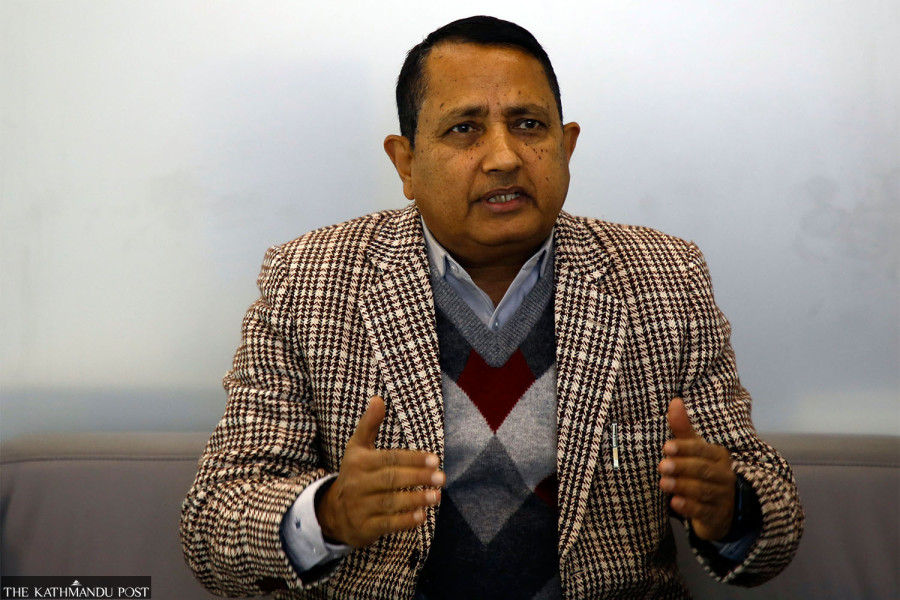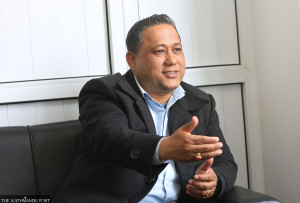Interviews
Nepal’s hydroelectricity is vital for India’s energy mix
We must maximise hydropower generation to replace fossil fuels in our market and help the neighbours in their clean energy transition.
Thira Lal Bhusal & Prithvi Man Shrestha
Nepal and India inked various deals last week including a long-term power trade agreement under which India agreed to buy 10,000MW in 10 years. Dinesh Ghimire, who retired a month ago from the post of energy secretary, is among those closely involved in negotiations with India in this connection. Thira Lal Bhusal and Prithvi Man Shrestha of the Post sat with him to understand the importance of the deal.
Nepal and India last week inked a deal on exporting 10,000MW of Nepal’s electricity. How significant is this development?
Let’s give a bit of background. In 2014, we concluded a power trade agreement with India aiming to export Nepal’s surplus electricity to the southern neighbour. Based on the same, we have started exporting electricity to India. In recent years, electricity generation has accelerated in Nepal. Now our total generation capacity has reached around 3,000MW while our demand is around 1,800MW. In a few years, we will be in surplus even in the dry season.
On the other hand, India is under tremendous pressure to adopt clean energy. In international climate summits, India has pledged to increase its non-fossil fuel-based energy capacity from current 180GW to 500GW by 2030, which is a daunting task. For that, it needs Nepal’s hydroelectricity. So we held several rounds of negotiations to increase our energy trade, as it is a win-win for both sides. Top political leaders of the two countries were convinced. Finally, Indian Prime Minister Narendra Modi, during our prime minister’s India visit last year, announced that India would buy 10,000MW in 10 years from Nepal. Now, with the signing of the deal last week, the announcement has been formalised.
We have to generate the maximum level of hydroelectricity from our water resources to replace fossil fuels in our market and to help our neighbours in their clean energy transition. A market for upto 10,000MW in 10 years has been ensured. There is a provision to further increase it. India is a huge energy absorber. Similarly, Bangladesh is another prospective market. Thus the new deal has laid a solid ground for Nepal’s hydropower development by ensuring a market for investors in this sector.
However, many people suspect India’s terms and conditions may still hinder the deal’s smooth implementation. Take its new guidelines on cross-border energy trade and dilly-dallying in approving more power projects to sell power in the Indian market.
The new long-term agreement does not exempt us from following India’s cross-border guidelines and procedures on the import and export of electricity. They have to follow our laws as well. We have to implement bilateral agreements while respecting each other’s laws. As India adopts stringent screening provisions and requires clearance from multiple agencies, the process to approve power import from Nepal may be delayed sometimes. It is also guided by the urgency of the needs and market dynamics.
A section of stakeholders are expressing concern if India would only buy power from India-invested projects under this deal. Would it be right to say India’s control over Nepal’s hydropower has been further strengthened?
It’s not true that India will buy electricity produced only by its developers. Electricity produced by Nepali developers or any company registered in Nepal can be included in the 10,000MW scheme. The energy produced by Indian developers or by joint venture companies involving Indian investors also will be counted. Similarly, projects developed by Koreans can be included. India may not be ready to buy electricity from certain neighbouring countries as its cross-border electricity trade guideline excludes them. But India can reconsider such a position in the future. How much India will buy from Nepal also depends on India’s systemic requirement.
India has made massive investments in solar and wind energy. But they are heading towards saturation in that category. They are struggling to manage peak load and balance the system. India is urgently in need of hydroelectricity to balance its system. So, I am confident that shortly they will demand more and more hydroelectricity from Nepal, no matter which country produces it. It is essential to their plan for a clean energy transition. They currently get most of their electricity from coal and are under tremendous pressure to replace it with clean energy. India’s total hydropower potential is said to be 73,000MW. They have already generated around 46,000MW. Thus, the remaining power generation capacity of India’s hydropower is limited compared to their needs. Importing electricity from neighbouring countries such as Nepal and Bhutan is therefore essential for their clean energy transition.
Many things also depend on negotiations with India. For instance, the Indian side was not ready to buy electricity generated by the 456MW Upper Tamakoshi citing the involvement of a Chinese contractor. We have clarified to the Indian side that it is a fully Nepal-funded project with both Indian and Chinese contractors involved in the construction. Lately, they have been positive about buying its power too.
When India for the first time opened its door for Nepal’s power exports in November 2021, it permitted only 39MW initially. Two years down the line, the quantum has climbed over 600MW. It is the result of negotiations.
When it comes to fear about India’s hold over Nepal’s hydropower, we have introduced FDI-friendly policies in the hydropower and invited investors. We are inviting developers as our domestic investment isn’t enough. Besides the huge Indian market, Bangladesh is also willing to collaborate with us to develop hydropower projects and buy our electricity. China can be another prospective market. While negotiating with other countries, we have to be tactful to ensure that our national interest isn’t compromised. When we see things practically, India is the easiest market for us from various perspectives. We can’t trade power with other countries in the same way as we can do with India.
But we shouldn’t discourage investment from any country, be it from India, China, South Korea, or any other country.
Why is hydroelectricity preferable to other sources such as solar, wind and nuclear energy?
Solar and wind plants can’t manage peak load as they can’t generate electricity in peak hours such as evening and night, whereas hydropower is the most stable and reliable source to manage peak hours. Similarly, nuclear energy has its downsides. It’s not cost-effective as uranium is quite costly. Controlling radiation hazards from nuclear plants is as expensive. There are other constraints in developing nuclear plants. Therefore, hydropower is taken as the most stable, reliable and cost-effective solution.
What are the things Nepal should do to realise the goal of 10,000MW export in 10 years?
First, we need to significantly improve our transmission capacity. Through our existing transmission capacity, we can do cross-border trade of hardly 1,300MW. At least five high-capacity cross-border transmission lines should be built in the next 10 years. We should also boost our domestic transmission capacity to take power to the cross-border line for export. For example, the developer of the Arun 3 project has completed constructing the Dhalkebar-Sitamarhi section of the cross-border power line but it is facing trouble in completing the domestic section of the transmission line to evacuate power from the project.
Second, how much power will be available for export if we start consuming more power in the country? As per our projection, Nepal’s domestic demand will reach 13,000 MW by 2035. We have the target of exporting around 5,000MW to Bangladesh by 2035, in addition to 10,000MW to India in the next 10 years. So we need to generate around 28,000MW in the next 10 years for domestic and export purposes. We should thus work simultaneously on generation and transmission.
When Nepal and India signed the power trade agreement last week, some water resources experts and activists questioned the government’s dealing with India arguing that the long-term agreement only saw Nepal’s water resources from the perspective of hydropower generation by ignoring the calculation of benefit from irrigation and flood control.
I agree with their argument, in principle. In multi-purpose projects, we have to factor in multiple uses of water. There are indeed more downstream benefits for India due to hydropower development in Nepal because it gets regulated water. We have to negotiate on the matter too which is a universally accepted practice. But the question here is whether it is better to take benefit by developing a hydropower project instead of never building the project under the pretext that India didn’t agree to pay for downstream benefits.
Some even question how Nepal benefits from exporting power to India from the India-invested projects.
The first benefit is the energy royalty that Nepal gets. For example, in the case of Arun-3, the developer pays two percent of what it gets from the energy sold in the Indian market in the first 15 years. In the next 15 to 30 years, it pays 10 percent energy royalty. Two, it pays capacity royalty at the rate of Rs 100 per kW for the first 15 years and Rs 1,000 per kW after 15 years. Third, it pays income tax. Fourth, we get 21.9 percent of the total energy produced by Arun 3 for free. Fifth, the entire project is handed over to the government after 30 years.
What is the progress on the proposed Nepal-Bangladesh energy trade?
The progress is encouraging. Nepal and Bangladesh are positive on energy trade and are working for joint investment in hydropower projects in Nepal. For this, we both need the support of India which lies between the two countries. There is a huge demand for clean energy in Bangladesh as they also have an ambitious target for transition to clean energy. The only issue is connectivity to transmit the power.
We have two options: One is to build a dedicated line through Indian territory. However, due to technical and various other reasons, this is very challenging. For now, the more feasible way to do energy trade with Bangladesh is by using India’s existing structures. India is positive about it. But the current capacity of the Indo-Bangladesh transmission line isn’t sufficient to transmit our energy. It can be upgraded by adding some equipment. We have asked both Bangladesh and India to fix that. There is an understanding to start trading 40MW at the start.




 7.98°C Kathmandu
7.98°C Kathmandu













